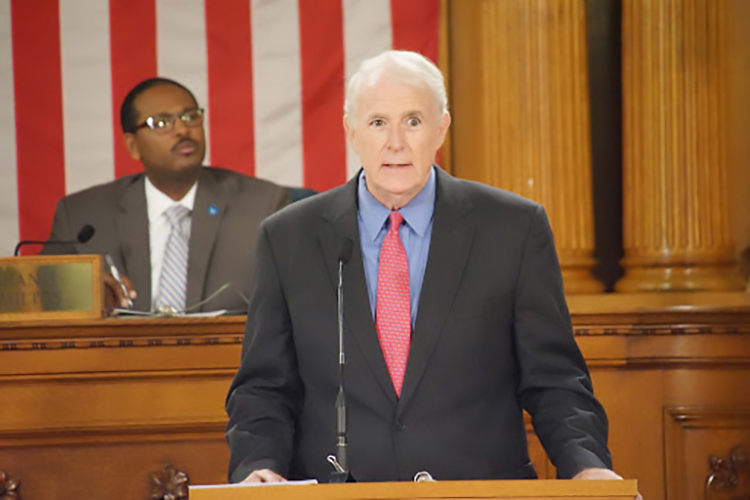 Plan to End Chronic Homelessness in Milwaukee County
Plan to End Chronic Homelessness in Milwaukee County
MILWAUKEE – Milwaukee County Executive Chris Abele will unveil a new plan to end chronic homelessness in Milwaukee County with Mayor Tom Barrett at the site of the new Thurgood Marshall Apartments on Tuesday, June 9. Through a mix of increased funding and strategic service placements, the plan will end chronic homelessness in Milwaukee County in three years.
“Although the County has been involved in addressing homelessness for years, we decided that incremental progress was no longer good enough for our community,” County Executive Chris Abele said. “We are ending chronic homelessness. And we are doing it in three years. I want to thank Mayor Tom Barrett for his support of this initiative and the City’s role, and I especially want to thank CDBG Director Steve Mahan and HOUSING AUTHORITY Executive Director Tony Perez. They are two great leaders for the City who, when we approached them with our plan, were incredibly supportive and have been fantastic partners throughout.”
Executive Director Tony Perez. They are two great leaders for the City who, when we approached them with our plan, were incredibly supportive and have been fantastic partners throughout.”
A chronically homeless individual is someone who has experienced homelessness for one year or longer, or who has experienced at least four episodes of homelessness in the last three years and has a DISABILITY . Instead of the traditional approach of providing short-term subsistence through the provision of shelter beds, this plan empowers the chronically homeless by providing housing that is permanent. Permanent housing is demonstrated to yield better outcomes for the chronically homeless and the community at-large.
. Instead of the traditional approach of providing short-term subsistence through the provision of shelter beds, this plan empowers the chronically homeless by providing housing that is permanent. Permanent housing is demonstrated to yield better outcomes for the chronically homeless and the community at-large.
“This initiative is a creative and cost-effective extension of the City/County HOUSING AUTHORITY partnership that, since 2008, has provided nearly 500 new permanent supportive housing units for individuals and families at risk of homelessness,” Mayor Tom Barrett said. “Now, we are collaborating to ADDRESS
partnership that, since 2008, has provided nearly 500 new permanent supportive housing units for individuals and families at risk of homelessness,” Mayor Tom Barrett said. “Now, we are collaborating to ADDRESS the needs of the most challenging segment of the homeless population in our community.”
the needs of the most challenging segment of the homeless population in our community.”
Through this innovative partnership, approximately $1.8 million will be devoted annually to ending chronic homelessness in Milwaukee County. These funds include case management and other related service dollars from Milwaukee County and rental assistance from the City of Milwaukee and the HOUSING AUTHORITY of the City of Milwaukee. Throughout their time in the program, participants will receive wraparound case management services from the Milwaukee County Housing Division to help address other needs that participants may have, including mental health and substance abuse issues. Case managers will also assess job readiness and help program participants find stable work.
of the City of Milwaukee. Throughout their time in the program, participants will receive wraparound case management services from the Milwaukee County Housing Division to help address other needs that participants may have, including mental health and substance abuse issues. Case managers will also assess job readiness and help program participants find stable work.
This approach will fund a significant expansion of the Housing First model, which is based on the approach that, despite often having many needs, a homeless individual or household’s first and primary need is to obtain stable, affordable, quality housing.
“By implementing the Housing First model in our community, we will be able to immediately place homeless individuals directly into permanent housing,” said Jim Mathy, Milwaukee County Housing Division Administrator. “Not only will this be a life-changing event for those that are experiencing homelessness, but national data shows that implementing Housing First also results in savings from reduced public service costs.”
Studies show that providing quality housing offers participants the sort of stability in their lives that leads to increases in positive activities like working and keeping families together while decreasing negative activities like involvement in the criminal justice system and trips to the emergency room. Not only will this benefit the individuals and their families, minimizing unnecessary involvement in the justice system will also save significant taxpayer dollars and improve public safety.
The goal of this initiative is to move individuals away from a dependence on government services and toward a support network that empowers them toward independence. The move to Housing First advances individuals toward independence by helping to address root level causes of social issues for this population and by shifting governmental strategy on homelessness from short-term fixes to long-term solutions. In doing so, the ripple effect of this initiative will lead to a community-wide benefit that touches all county residents.
“In the last four years, we took the difficult STEPS of improving our fiscal condition and reducing our debt and borrowing costs at the County,” said County Executive Abele. “The reason we took those steps was to create the capacity to tackle Milwaukee’s big issues in a substantive way. I’m proud to say that the Plan to End Chronic Homelessness in Milwaukee County does just that.”
of improving our fiscal condition and reducing our debt and borrowing costs at the County,” said County Executive Abele. “The reason we took those steps was to create the capacity to tackle Milwaukee’s big issues in a substantive way. I’m proud to say that the Plan to End Chronic Homelessness in Milwaukee County does just that.”




